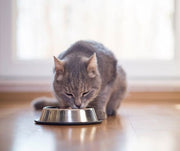Why Do Cats Purr?

What's more cozy that having a purring kitten cuddle up next to you? Purring seems to be the most obvious sign that your cat is content, but what causes it? Why and how exactly do cats purr? If this is something you've ever wondered about your feline friend, read on!
WHAT IS PURRRING, EXACTLY?
Before we can understand why our cats purr, it is important to know exactly what purring truly is. Purring is essentially the relaxing of a cat's vocal cord muscles. When a cat finds a sense of relaxation, the muscles surrounding their vocal cords vibrate as they inhale and exhale.
CONTENTMENT
Cats are smart creatures and have learned from humans that they gain more attention when they purr. A cat normally purrs when they are sitting on their owner's lap, soaking in all the love. Petting and enjoying time with your cat often triggers this reaction.
COPING MECHANISM
When you are feeling down or are dealing with pain, whether physical, mental, or otherwise, do you have something you do that helps you cope? The answer is likely yes. As humans, we have a number of ways we deal with pain or being uncomfortable. For example, some people hum or sing to help them cope with stress. This is what cats do as well. Scientists have also deduced that various frequencies associated with purring help to steady breathing, reduce pain, and even build muscles. A laboring cat will sometimes purr in the midst of some of their worst pain.
CALMING DOWN
Sometimes, cats will purr at some of the oddest times. Shelter owners report cats purring without anyone else around. Veterinarians often see cats purring on examination tables when they are obviously frightened. Purring is also a way for cats to deal with an uncomfortable situation. Cats get nervous when they are out of their normal routine, which is why they might start purring in stressful situations. This coping mechanism is very similar to anxiety-related behaviors. For example, some people may have nervous tics such as tapping their fingers or jiggling their leg up and down when stressed. Purring can often serve as the same solution for cats, and some studies suggest that purring may even have healing properties.

GUIDING THEIR KITTENS
Lastly, and instinctually, purring helps newborn kittens get to know their mother. Kittens are born blind and deaf, but the reverberations from purring allows the kittens to find their mother, who uses purrs as a directional reference or a call for her babies, making it easier for them to follow or locate her. Mother cats often use purring as a sort of "lullaby" for their newborn litter.
CONCLUSION
If your cat is alone, seemingly unharmed, and purring, they might be perfectly content, but sometimes their purring could the result of pain or anxiety. Ensure that you understand your cat's anxiety levels and you'll likely be able to tell whether your cat is purring with content or stress. Cats are remarkably like humans with their emotions, so it is important that pay attention to your cat's body language and purrs.
Previous article

Next article

Related posts
View all-

Keep Your Pets Safe During the Holidays
The holiday season brings joy, festivities, and a break from the usual routine. While you're enjoying the celebrations, it's important to remember that the holidays can present unique challenges for our furry family members. The new sights, sounds, and people can be overwhelming, and common festive items can pose unexpected risks.
Read Article -

Holiday Gifts for Every Pet Personality: The Ultimate Guide
The holiday season is finally here, and for many of us, that means finding the perfect presents for the ones we love most—our pets. Whether they are a steadfast dog who never leaves your side or an independent cat who graces you with their presence on their own terms, our pets are cherished members of the family. They deserve to celebrate right alongside us, stocking stuffers and all.
Read Article -

How to Keep Your Pet Calm During Thanksgiving
Thanksgiving is a time for family, friends, and food, but for our pets, the holiday can be overwhelming. The sudden change in routine, unfamiliar faces and scents, and increased noise can trigger significant stress. Understanding why your pet might feel anxious is the first step toward creating a peaceful holiday experience for everyone, including your furry family members. This guide offers calming tips for pets and practical solutions to ensure your dog or cat feels safe and secure during the festivities.
Read Article



